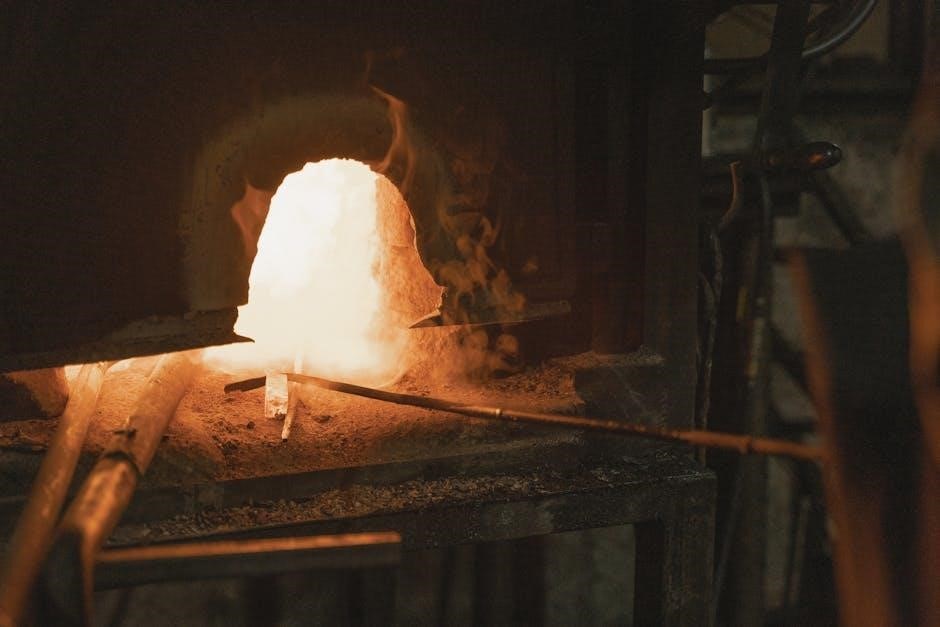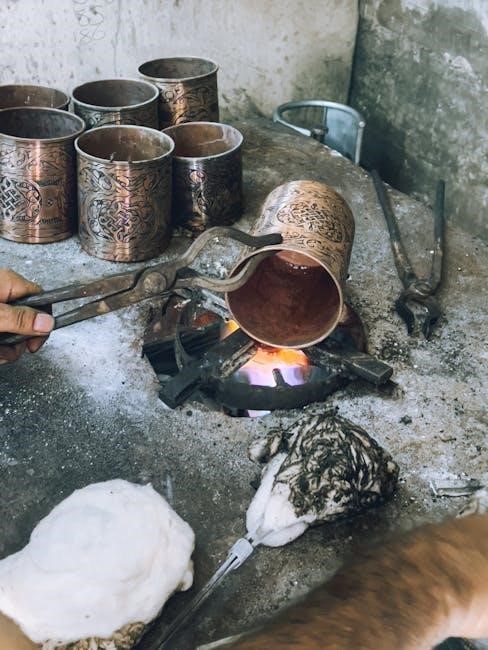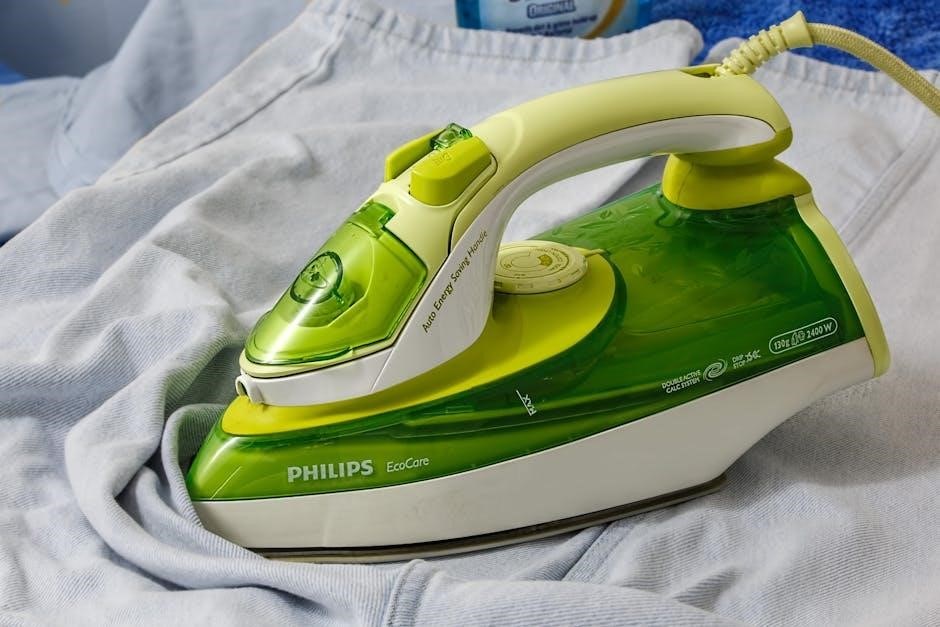Rowenta Iron Manual: A Comprehensive Guide
Welcome to your comprehensive guide for Rowenta irons! This resource provides detailed information to help you maximize the performance and lifespan of your Rowenta iron. You’ll find instructions and tips for safe and effective ironing.
Finding Your Rowenta Iron Manual
Locating your Rowenta iron manual is crucial for understanding your specific model’s features and operating instructions. Start by checking the original packaging; the manual is often included. If you’ve misplaced the physical copy, the Rowenta website is an excellent resource. Navigate to the “Support” or “Customer Service” section and search for your model number.
Rowenta’s online database typically contains downloadable PDF versions of manuals. Websites like ManualsLib and ManualsOnline also host a wide variety of user manuals for various Rowenta iron models. Inputting your model number into a search engine like Google can quickly yield results.
Many online retailers that sell Rowenta irons also provide links to the user manuals on the product pages. If you still cannot find your specific manual, consider contacting Rowenta’s customer support directly through their website or phone. They can often provide digital copies or guide you to the correct resource. Remember, having the correct manual ensures safe and effective use of your Rowenta iron.
Understanding Your Rowenta Iron Model
Rowenta offers a diverse range of irons, each with unique features and capabilities. Identifying your specific model is the first step toward proper usage and maintenance. Look for the model number printed on the iron itself, typically located on the soleplate, the handle, or the water tank. This number is essential for accessing the correct manual and support resources.
Different Rowenta models boast varying steam outputs, soleplate materials, and special functions like precision tips or eco-modes. Understanding these features will help you tailor your ironing technique to different fabrics and garment types. Consult your manual for detailed specifications and recommended settings for various fabrics, such as cotton, linen, silk, and wool.
Familiarize yourself with the iron’s controls, including temperature settings, steam settings, and any special feature buttons. Pay attention to the indicator lights, which often signal when the iron is heating up, ready to use, or in eco-mode. Proper understanding of your Rowenta iron model will ensure optimal performance and prevent accidental damage to your garments.
Essential Safety Instructions
Safety should always be your top priority when using any electrical appliance, including your Rowenta iron. Before you begin, carefully read all safety instructions provided in the user manual. Always ensure the iron is placed on a stable and heat-resistant surface when not in use, and never leave it unattended while it’s turned on. Keep the iron away from flammable materials and out of reach of children and pets.
Never immerse the iron in water or any other liquid. Regularly inspect the power cord for damage, and if any damage is detected, do not use the iron. Always unplug the iron from the electrical outlet before filling or emptying the water tank, and before cleaning or storing it. Avoid ironing garments while they are being worn, and never direct steam towards people or animals.
Be mindful of the hot soleplate and steam, as they can cause severe burns. Allow the iron to cool completely before storing it. If you notice any unusual smells, sounds, or malfunctions, immediately turn off and unplug the iron and contact Rowenta customer support for assistance. By following these essential safety instructions, you can ensure a safe and enjoyable ironing experience.
Water Usage Guidelines
Using the correct type of water in your Rowenta iron is crucial for its longevity and performance. Rowenta irons are designed to operate using untreated tap water with a hardness level up to 17 dH (German water hardness). If you are unsure about the hardness of your tap water, consult your local water authority for information. Avoid using water that has been softened or contains additives, as these can damage the iron’s internal components.
Distilled water is generally acceptable, but using only distilled water over a long period may lead to mineral buildup. A mix of 50% tap water and 50% distilled water is often recommended for optimal performance. Never use water that contains perfumes, oils, or other additives, as these can clog the steam vents and leave residue on your clothes.
When filling the water tank, do not overfill it beyond the maximum fill line. Regularly empty the water tank after each use to prevent mineral buildup and potential leaks. If you live in an area with very hard water, consider using filtered water to further reduce the risk of mineral deposits. Following these water usage guidelines will help maintain your iron’s efficiency and extend its lifespan, ensuring consistently excellent ironing results.
Operating Instructions: Temperature and Steam Control
To achieve optimal ironing results with your Rowenta iron, understanding temperature and steam control is essential. Start by checking the garment’s care label for recommended ironing settings. Use the temperature control dial to select the appropriate fabric setting, such as cotton, linen, silk, wool, or synthetic. Allow the iron to heat up completely before use, indicated by the temperature light turning off.
For steam ironing, ensure the water tank is filled to the appropriate level. Adjust the steam control to match the fabric type; higher steam settings are suitable for thicker fabrics like cotton and linen, while lower settings are best for delicate materials like silk. For stubborn wrinkles, utilize the burst of steam function by pressing the designated button. This provides a powerful shot of steam to penetrate and relax the fabric.
When ironing without steam (dry ironing), ensure the steam control is set to the “dry” position. Always test the iron on an inconspicuous area of the garment first to prevent damage. Regularly clean the soleplate to maintain smooth gliding and prevent residue buildup. Proper temperature and steam control ensures efficient and safe ironing, protecting your clothes while achieving professional-quality results.
Using the Self-Cleaning Function
Maintaining your Rowenta iron’s performance requires regular use of the self-cleaning function. This process removes mineral deposits and impurities that can accumulate over time, ensuring optimal steam production and preventing staining of your garments. Before initiating the self-cleaning cycle, ensure the iron is unplugged and has completely cooled down. Fill the water tank to its maximum level.
Next, hold the iron horizontally over a sink or basin. Locate the self-clean button, typically marked and press and hold it down. Gently shake the iron back and forth to help dislodge any scale particles inside the steam chamber. Steam and hot water will begin to expel from the soleplate, carrying away the impurities. Continue this process for about one minute, or until the water runs clear.

After the self-cleaning cycle is complete, plug the iron back in and allow it to heat up again to evaporate any remaining water. Once cooled, wipe the soleplate with a damp cloth to remove any residual debris. Perform the self-cleaning function every 1-3 months, depending on water hardness, to prolong the life of your Rowenta iron and maintain its efficiency. This simple maintenance step keeps your iron working like new.
Troubleshooting Common Issues

Even with careful use, you may encounter issues with your Rowenta iron. One common problem is the iron not heating up. First, ensure the iron is properly plugged into a functioning outlet. Check that the temperature control is set to the desired level. If the iron still doesn’t heat, the thermal fuse may have blown, requiring professional repair.
Another frequent concern is water leakage. This can occur if the iron is overfilled or if the temperature setting is too low for steam production. Reduce the water level and increase the temperature. If leaking persists, the soleplate may need cleaning. Mineral buildup can obstruct steam vents, causing condensation and leakage. Use the self-cleaning function to clear these blockages.
If the iron produces insufficient steam, check that the water tank is full and the steam control is properly adjusted. Also, ensure the soleplate vents are free from obstructions. Mineral deposits are a common culprit, so run the self-cleaning cycle to remove them. Finally, if you notice brown stains on your clothes, this indicates scale buildup. Regularly using distilled water helps prevent this, but if stains occur, clean the soleplate thoroughly and use the self-cleaning function more frequently.
Exploring Special Features: Precision Tip and Eco Mode
Rowenta irons often come equipped with special features designed to enhance your ironing experience. Two notable features are the precision tip and Eco mode. The precision tip is a specifically designed pointed edge on the soleplate. This allows for effortless ironing around buttons, collars, and other hard-to-reach areas. Its design ensures that you can achieve crisp, clean results even in intricate garment details. By using the precision tip, you can eliminate the need for additional tools or techniques to achieve a professionally ironed look.
Eco mode is an energy-saving setting that reduces the iron’s power consumption without sacrificing performance. When activated, Eco mode optimizes the temperature and steam output to use up to 20% less energy compared to standard settings. This mode is ideal for everyday ironing needs and lighter fabrics, helping you conserve energy and reduce your carbon footprint while still achieving excellent results. Using Eco mode is a simple way to make your ironing routine more environmentally friendly without compromising on the quality of your garment care.
Maintenance and Storage Tips
Proper maintenance and storage are crucial for extending the life of your Rowenta iron and maintaining its performance. After each use, allow the iron to cool completely before storing it. This prevents damage to the soleplate and internal components. Empty the water tank to avoid mineral buildup and potential leaks. Wipe the soleplate with a damp cloth to remove any residue or starch. For stubborn stains, use a non-abrasive cleaner specifically designed for iron soleplates. Regular cleaning ensures smooth gliding and optimal steam distribution.
When storing your Rowenta iron, choose a cool, dry place away from direct sunlight and extreme temperatures. Wrap the cord loosely to prevent tangling and damage. Store the iron upright on its heel rest or in a designated storage case to protect the soleplate from scratches. Avoid placing heavy objects on top of the iron, as this can cause deformation or breakage. Periodic maintenance, such as descaling and cleaning the steam vents, will also help keep your iron in top condition. By following these simple tips, you can ensure your Rowenta iron remains a reliable tool for years to come.
Deciphering Error Codes (if applicable)
Modern Rowenta irons equipped with digital displays may occasionally show error codes. These codes are diagnostic messages designed to help you identify and resolve potential issues. Refer to your iron’s manual for a comprehensive list of error codes and their corresponding meanings. Common error codes may indicate problems such as overheating, low water levels, or sensor malfunctions. When an error code appears, first consult the manual for troubleshooting steps specific to that code.
Try simple solutions like refilling the water tank, checking the power connection, or allowing the iron to cool down. If the error persists, unplug the iron and contact Rowenta customer support for further assistance. Provide them with the error code and a description of the issue. Do not attempt to disassemble or repair the iron yourself, as this could void the warranty and pose a safety risk. Understanding error codes allows you to quickly diagnose problems. This ensures efficient troubleshooting and minimizes downtime. Keep your manual handy for quick reference.

Where to Find Additional Support and FAQs

If you encounter any issues with your Rowenta iron that are not covered in the manual, there are several resources available to provide additional support. The first place to check is the official Rowenta website. Here, you can find a comprehensive FAQ (Frequently Asked Questions) section that addresses common problems and concerns. The website also provides access to downloadable manuals, troubleshooting guides, and video tutorials.
For more personalized assistance, you can contact Rowenta’s customer support team via phone, email, or live chat. Be prepared to provide your iron’s model number and a detailed description of the issue you are experiencing. Many online forums and communities dedicated to home appliances can offer valuable insights and solutions from other Rowenta iron users. These forums can be a great place to find tips, tricks, and workarounds for common problems. Remember to exercise caution when following advice from unofficial sources. Always prioritize safety and consult the official manual or Rowenta’s customer support for reliable guidance.
